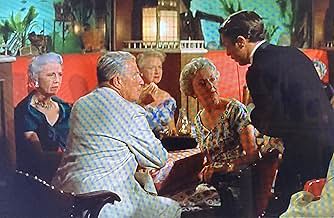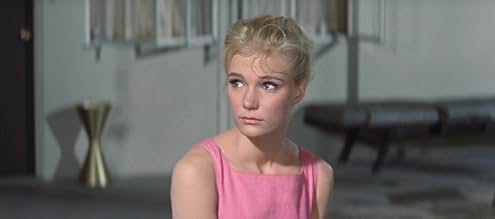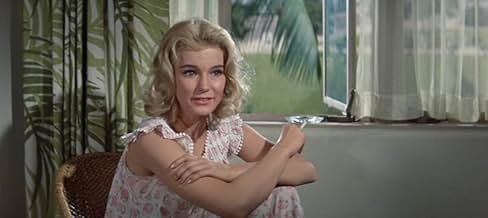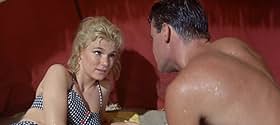NOTE IMDb
6,7/10
3,3 k
MA NOTE
Ajouter une intrigue dans votre langueFour very different college girls drive to Fort Lauderdale, Florida for spring break and seek out various adventures and romance for themselves.Four very different college girls drive to Fort Lauderdale, Florida for spring break and seek out various adventures and romance for themselves.Four very different college girls drive to Fort Lauderdale, Florida for spring break and seek out various adventures and romance for themselves.
- Réalisation
- Scénario
- Casting principal
- Récompenses
- 2 nominations au total
Carol Byron
- Sybil
- (non crédité)
John Cliff
- Policeman at Hospital
- (non crédité)
Oliver Cross
- Nightclub Patron
- (non crédité)
Jack Deery
- Nightclub Patron
- (non crédité)
Amy Douglass
- Dr. Raunch
- (non crédité)
Dennis Durney
- Young Man
- (non crédité)
Avis à la une
i don't understand how anyone cannot like this film! the story about the 4 co-eds is mind-grabbing but i couldn't help wondering if all that sex talk would be looked upon well, it being the good old sixties. i would descibe this film as smooth, quirky, dramatic, and fun. i am a HUGE fan of frank gorshin and i loved his portrayl of basil. the whole cast was was very good and that made it a great film. i usually rent this film at least once a month. but am i the only one who adores basil's glasses?
Where The Boys Are (1960 Dir. Henry Levin) Fort Lauderdale College Spring Break! Oh Boy! Oh Girl! See where the perennially tan George Hamilton first acquired his swarthy complexion. Also features one of the best '60s light comediennes Paula Prentiss as "Tuggle Carpenter". Lots of talk amongst the girls about how far they should go. Lots of talk amongst the boys about how far they've gotten. A classic American take on life when the air was clean and sex was dirty. Before there was MTV's Spring Break, there was this movie. Great for viewing with mixed company (that's old-fashioned slang for boys and girls together).
WHERE THE BOYS ARE is very much worth seeing, although extremely dated and a movie that would probably make today's 18 year-old laugh out loud at the innocent boy-meets-girl shenanigans of kids in an era before string bikinis and drunken riots in Fort Lauderdale.
Delores Hart is the crown jewel in this, the very first, "beach movie" that launched a whole summertime surf-romance culture of sand and two- piece swimsuits that, just a few years later, spawned Annette Funicello and Frankie Avalon in their BEACH BLANKET money-makers.
Hart is the embodiment of the girl next door with a face that could melt granite as she, Connie Francis, Yvette Mimeaux, and Paula Prentiss drive down to Fort Lauderdale during spring break in search of boys. They hook up with Frank Gorshin, Jim Hutton, and rich boy George Hamilton. The antics that ensue are so saccharine you could pour them over ice cream as a substitute for chocolate syrup.
It is the Hart-Hamilton romance that is the focal point as Hamilton tries unsuccessfully to seduce Hart on his father's yacht. Near the end, Hart thinks he has dumped her when he fails to show. A disconsolate Hart is left alone on the beach and wonders if she'll ever meet Mr. Right. The final scene between Hart and Hamilton offers a touching romantic twist and caps the whole thing nicely. Of course, the movie's theme song, WHERE THE BOYS ARE, would become Connie Francis'signature piece in years to come.
WHERE THE BOYS ARE is certainly dated, but its depiction of a benign teen culture shows us the world of summertime youth before mores,language, and music took a radical turn toward sex, drugs, and rock and roll.
TRIVIA: Anyone who doubts the existence of real, religious vocation should study the life of Delores Hart. She had made about 8-10 movies including two with Elvis--KING CREOLE and LOVING YOU. Then making the whopping sum of about $50,000 a picture, she was being groomed as the next Grace Kelley when she announced, in 1964, she was entering a convent to become a Catholic nun! Studio producers were beside themselves and most of Hollywood reacted with skepticism thinking it was a publicity stunt. She was, in fact, engaged at that time and her fiancée was heartbroken. But she entered a convent in Bethlehem, Conn. and remains there to this day as Mother Delores!...About 2-3 yrs. ago Hart was interviewed on 20--20 and disclosed she had a rare and painful nervous disorder that limits her movements. But her spirits were high and she spoke easily of the old Hollywood days, hiding nothing, even describing Presley as sensitive and a great guy...Yvette Mimeaux would marry MGM dance choreography Stanley Donan in the 1970's...Paula Prentiss would marry actor Richard Benjamin (GOODBYE COLUMBUS)...And Connie Francis? This is a life story waiting to be produced on the screen. For anyone interested in the real life tragedy of Connie Francis, read WHO'S SORRY NOW.....
Dennis Caracciolo
Delores Hart is the crown jewel in this, the very first, "beach movie" that launched a whole summertime surf-romance culture of sand and two- piece swimsuits that, just a few years later, spawned Annette Funicello and Frankie Avalon in their BEACH BLANKET money-makers.
Hart is the embodiment of the girl next door with a face that could melt granite as she, Connie Francis, Yvette Mimeaux, and Paula Prentiss drive down to Fort Lauderdale during spring break in search of boys. They hook up with Frank Gorshin, Jim Hutton, and rich boy George Hamilton. The antics that ensue are so saccharine you could pour them over ice cream as a substitute for chocolate syrup.
It is the Hart-Hamilton romance that is the focal point as Hamilton tries unsuccessfully to seduce Hart on his father's yacht. Near the end, Hart thinks he has dumped her when he fails to show. A disconsolate Hart is left alone on the beach and wonders if she'll ever meet Mr. Right. The final scene between Hart and Hamilton offers a touching romantic twist and caps the whole thing nicely. Of course, the movie's theme song, WHERE THE BOYS ARE, would become Connie Francis'signature piece in years to come.
WHERE THE BOYS ARE is certainly dated, but its depiction of a benign teen culture shows us the world of summertime youth before mores,language, and music took a radical turn toward sex, drugs, and rock and roll.
TRIVIA: Anyone who doubts the existence of real, religious vocation should study the life of Delores Hart. She had made about 8-10 movies including two with Elvis--KING CREOLE and LOVING YOU. Then making the whopping sum of about $50,000 a picture, she was being groomed as the next Grace Kelley when she announced, in 1964, she was entering a convent to become a Catholic nun! Studio producers were beside themselves and most of Hollywood reacted with skepticism thinking it was a publicity stunt. She was, in fact, engaged at that time and her fiancée was heartbroken. But she entered a convent in Bethlehem, Conn. and remains there to this day as Mother Delores!...About 2-3 yrs. ago Hart was interviewed on 20--20 and disclosed she had a rare and painful nervous disorder that limits her movements. But her spirits were high and she spoke easily of the old Hollywood days, hiding nothing, even describing Presley as sensitive and a great guy...Yvette Mimeaux would marry MGM dance choreography Stanley Donan in the 1970's...Paula Prentiss would marry actor Richard Benjamin (GOODBYE COLUMBUS)...And Connie Francis? This is a life story waiting to be produced on the screen. For anyone interested in the real life tragedy of Connie Francis, read WHO'S SORRY NOW.....
Dennis Caracciolo
Forty-five years have elapsed since its original release, but it is amazing how this 1960 film introduced a particular genre that continues to be produced today granted in a far more explicit manner - the spring-break, beach-party movie where attractive teens go through a sun-drenched mating ritual and somehow love triumphs over carnal knowledge. Back then, the concept didn't seem quite as jaded as it does now, and consequently there is an entertaining naiveté about the timeworn story of four co-eds from a snowy Midwestern college who journey to Ft. Lauderdale for spring break to meet boys.
The plot is based on the then-accepted notion that girls in college are only marking time waiting for husbands to come along, but the journey to that goal depends on the girl. The four in question are Merritt, a smart blonde who is not living up to her academic potential as she questions the moral code around premarital sex; Melanie, so deeply insecure she mistakes sex for love with a less-than-honorable Ivy Leaguer; Tuggle, a tall brunette who zeroes in on an even taller, eccentric hitchhiker; and Angie, the supposedly plain one who gets used to being ignored by men.
Directed in a perfunctory fashion by Henry Levin, this is not the type of movie where you are terribly impressed with the performances, but I have to say the acting is certainly miles above subsequent beach-party movies. Elvis' former leading lady Dolores Hart plays Merritt credibly even as she is being seduced by a youthful George Hamilton wanly playing Ryder, a well-to-do Ivy Leaguer with a conveniently located yacht. As the most troubled of the girls, Yvette Mimieux (always loved her name) accurately captures the constantly forlorn, little-girl-lost state of Melanie, a teen-aged Blanche du Bois in the making.
So pert and charming as Angie, Connie Francis actually seems miscast as a plain-Jane, especially when she sings "Turn on the Sunshine" with a stage polish completely out of character. The standout is Paula Prentiss who portrays Tuggle with her unique personality in full bloom and partnered the first of several times with Jim Hutton as the comically obnoxious TV. She is an under-appreciated comedienne with a loopy charm and vibrantly twangy voice all her own - it's a shame her career never really took off the way it deserved to.
I think the film does make a valid, sometimes even perceptive attempt to address the confusion that Eisenhower-era girls had over sex and love. Girls were expected to function under a double-standard where the only way to attract boys was to have something to offer but at the price of their reputations. This point is hammered home when the tone shifts in the last portion to melodrama. At the same time, the film is filled with predictable comic scenes, including a contrived mêlée in an underwater tank with the zaftig and nasal Barbara Nichols as Esther Williams-wannabe Lola Fandango.
Prentiss offers her services and remembrances to the alternate audio commentary track on the DVD, which also comes with a looking-back featurette which includes interviews with Prentiss and Francis. Who knew this film would launch a hundred imitations? The minute you hear Francis sing the title tune, it is hard for a baby boomer not to get nostalgic. If you have an interest in understanding the mid-century moral code enforced upon the youth of America, especially girls, I can think of worse films to see.
The plot is based on the then-accepted notion that girls in college are only marking time waiting for husbands to come along, but the journey to that goal depends on the girl. The four in question are Merritt, a smart blonde who is not living up to her academic potential as she questions the moral code around premarital sex; Melanie, so deeply insecure she mistakes sex for love with a less-than-honorable Ivy Leaguer; Tuggle, a tall brunette who zeroes in on an even taller, eccentric hitchhiker; and Angie, the supposedly plain one who gets used to being ignored by men.
Directed in a perfunctory fashion by Henry Levin, this is not the type of movie where you are terribly impressed with the performances, but I have to say the acting is certainly miles above subsequent beach-party movies. Elvis' former leading lady Dolores Hart plays Merritt credibly even as she is being seduced by a youthful George Hamilton wanly playing Ryder, a well-to-do Ivy Leaguer with a conveniently located yacht. As the most troubled of the girls, Yvette Mimieux (always loved her name) accurately captures the constantly forlorn, little-girl-lost state of Melanie, a teen-aged Blanche du Bois in the making.
So pert and charming as Angie, Connie Francis actually seems miscast as a plain-Jane, especially when she sings "Turn on the Sunshine" with a stage polish completely out of character. The standout is Paula Prentiss who portrays Tuggle with her unique personality in full bloom and partnered the first of several times with Jim Hutton as the comically obnoxious TV. She is an under-appreciated comedienne with a loopy charm and vibrantly twangy voice all her own - it's a shame her career never really took off the way it deserved to.
I think the film does make a valid, sometimes even perceptive attempt to address the confusion that Eisenhower-era girls had over sex and love. Girls were expected to function under a double-standard where the only way to attract boys was to have something to offer but at the price of their reputations. This point is hammered home when the tone shifts in the last portion to melodrama. At the same time, the film is filled with predictable comic scenes, including a contrived mêlée in an underwater tank with the zaftig and nasal Barbara Nichols as Esther Williams-wannabe Lola Fandango.
Prentiss offers her services and remembrances to the alternate audio commentary track on the DVD, which also comes with a looking-back featurette which includes interviews with Prentiss and Francis. Who knew this film would launch a hundred imitations? The minute you hear Francis sing the title tune, it is hard for a baby boomer not to get nostalgic. If you have an interest in understanding the mid-century moral code enforced upon the youth of America, especially girls, I can think of worse films to see.
Like many others who have commented previously on Where the Boys Are (WTBA), I was initially rather shocked at the film's frank discussion of sex. Once I thought about it more deeply, however, it was the open talk of marriage that was really fresh to my ears. I was born 11 years after this film was released and watching movies like this gives me a unique insight into history that goes well beyond the broad brushes of most sixties reviews and textbooks. Clearly both boys and girls of the time were struggling with the implications of sexuality in relationships - not a whole lot different than today.
What is different about WTBA than the films for young people of today or of my youth (e.g., The Breakfast Club) is the explicit discussion of marriage. In WTBA both the girls and the boys use different levers to try to achieve their ends. The girls use the potential for sex to get the one thing they want - marriage - and the boys use the potential for marriage to get what they are after - sex. I was amazed to hear that all the girls (even the one with an IQ of 138!) were so focussed on catching a husband at 19. None of the movies for youth that I have seen recently even touch the subject of marriage except maybe to joke about it.
While many would argue that no one gets married at 19 anymore, that ultimate end of any relationship still looms out there for young people like a giant prize (or punishment) at the end of dating. The only help I got in seeing young people get together and eventually get married was in The Princess Bride, which could easily be dismissed as fairy tale. I recall in my late teens having to turn to more adult movies like When Harry Met Sally or even Enchanted April to find some guidance for seeing a relationship through to its logical end. Maybe today's youth are skipping over She's All That and going to movies like High Fidelity for similar answers. One would hope so.
So instead of a breezy beach movie I got a social history lesson on the mating rituals of my parents' generation. I hope there's a movie that prompts this kind of discussion for my own kids someday.
What is different about WTBA than the films for young people of today or of my youth (e.g., The Breakfast Club) is the explicit discussion of marriage. In WTBA both the girls and the boys use different levers to try to achieve their ends. The girls use the potential for sex to get the one thing they want - marriage - and the boys use the potential for marriage to get what they are after - sex. I was amazed to hear that all the girls (even the one with an IQ of 138!) were so focussed on catching a husband at 19. None of the movies for youth that I have seen recently even touch the subject of marriage except maybe to joke about it.
While many would argue that no one gets married at 19 anymore, that ultimate end of any relationship still looms out there for young people like a giant prize (or punishment) at the end of dating. The only help I got in seeing young people get together and eventually get married was in The Princess Bride, which could easily be dismissed as fairy tale. I recall in my late teens having to turn to more adult movies like When Harry Met Sally or even Enchanted April to find some guidance for seeing a relationship through to its logical end. Maybe today's youth are skipping over She's All That and going to movies like High Fidelity for similar answers. One would hope so.
So instead of a breezy beach movie I got a social history lesson on the mating rituals of my parents' generation. I hope there's a movie that prompts this kind of discussion for my own kids someday.
Le saviez-vous
- AnecdotesPaula Prentiss signed a seven-year contract with MGM in 1960 when she was cast in this movie. She was living with boyfriend actor Richard Benjamin at the time, which was taboo in those days, and the studio didn't want her traveling on promotion junkets with a man who wasn't her spouse. So they asked the two to wed, though not before milking the wedding for publicity. Prentiss had to make long-distance calls to gossip columnists Hedda Hopper and Louella Parsons just before the ceremony, according to People. They were married by a New York judge on Oct. 26, 1961. They are still together as of 2022.
- GaffesWhen the kids are first introduced to Basil's jazz band, hundreds of kids rush to the bar, with the main characters in the rear. Yet, the main characters somehow manage to find one of the few tables in the bar.
- Citations
Police Captain: Wait a minute! Haven't I seen you in here before?
Lola Fandango: Just once, and it was purely by accident. The night my strap broke?
[she shows her very revealing top]
- Crédits fous"and introducing Connie Francis"
- ConnexionsFeatured in Where the Boys Were: A Retrospective (2004)
- Bandes originalesWhere the Boys Are
Words by Howard Greenfield
Music by Neil Sedaka
Performed by Connie Francis (uncredited)
Courtesy of Nevins - Kirshner
Meilleurs choix
Connectez-vous pour évaluer et suivre la liste de favoris afin de recevoir des recommandations personnalisées
Détails
- Date de sortie
- Pays d’origine
- Sites officiels
- Langue
- Aussi connu sous le nom de
- Se necesitan dos para amar
- Lieux de tournage
- Fort Lauderdale, Floride, États-Unis(some exteriors)
- Société de production
- Voir plus de crédits d'entreprise sur IMDbPro
- Durée
- 1h 39min(99 min)
- Rapport de forme
- 2.35 : 1
Contribuer à cette page
Suggérer une modification ou ajouter du contenu manquant






























